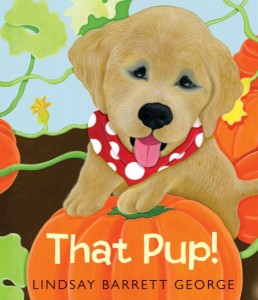Written and illustrated by Lindsay Barrett George
Greenwillow Books, 2011
9780062004130
What is that pup up to?
That pup digs. And digs. And digs some more.
What is that pup looking for? And why should this squirrel care?
"Children love puppies and squirrels. Drop those two ubiquitous characters into a natural fall setting, and you get the idea behind this bright picture book, told from the perspective of the dog’s owner. The use of gouache gives a clean, exquisitely bright quality to the close-ups of nature that proceed page after page. A spirited golden retriever smells acorns and has great fun digging them up in a sunflower garden, a pumpkin patch, under an apple tree, until she comes upon a squirrel, confronting her in a nearly wordless spread. Leading up to that point, young viewers and listeners will notice with anticipation the squirrel’s presence getting closer and closer. The squirrel wants to know what the pup is doing digging up the 10 acorns purposely hidden for winter. Instead of quarreling, the puppy suggests, “We can play a new game,/It’s called Put Back the Acorn.” An endearing spread shows them doing just that. Young readers will pore over the details in these simple, realistic illustrations, full of love for the natural world, and will find themselves reflected in the playful, cooperative story line."—School Library Journal
"Who can resist a cute little puppy, fashionably attired in a bandana and playing in the backyard—especially when pictured in George’s signature brightly colored but realistic style? However, this book offers much more than cute pictures. This day the little puppy’s playing involves finding acorns all over the backyard, on what is clearly a beautiful autumn day. But when the puppy gets to ten she bumps into a squirrel—who can be found hiding on all the pages up to this one. When the squirrel points out that she has carefully hidden all the acorns, the puppy helps her put them back. In addition to the counting aspect of the story, there is a good use of directional language to help spatial thinking. The spare text has an appealing conversational tone; the way it is printed in large type and the close picture text match may invite emerging readers to try reading it for themselves. Teachers and parents of Pre-K and kindergarten age children are likely to find many ways to return to this book again and again."—Children’s Literature

